seats ACURA ZDX 2010 Owners Manual
[x] Cancel search | Manufacturer: ACURA, Model Year: 2010, Model line: ZDX, Model: ACURA ZDX 2010Pages: 645, PDF Size: 17.13 MB
Page 10 of 645
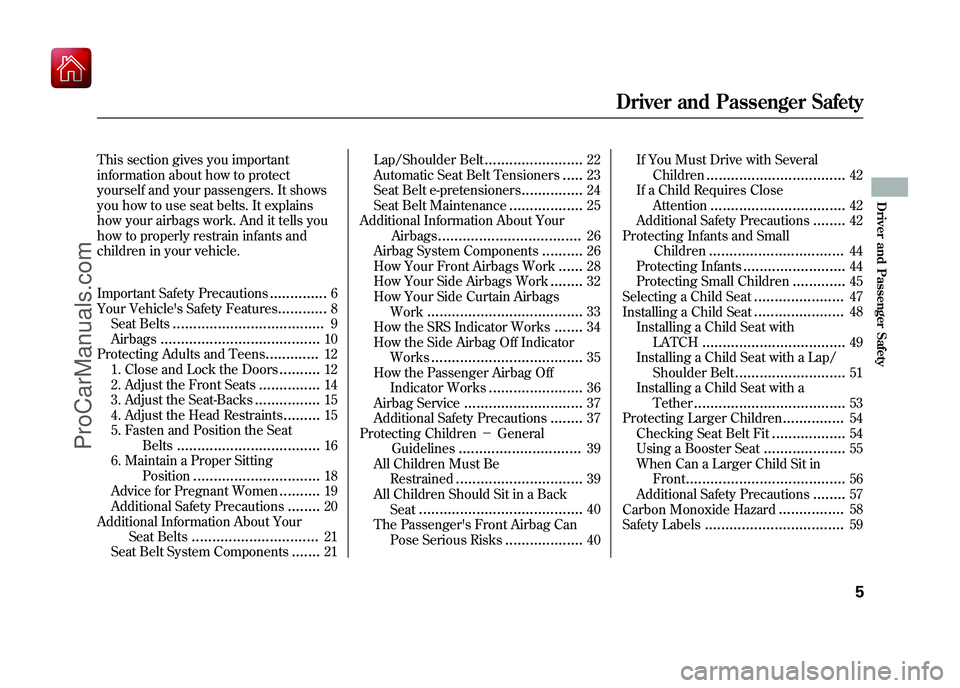
This section gives you important
information about how to protect
yourself and your passengers. It shows
you how to use seat belts. It explains
how your airbags work. And it tells you
how to properly restrain infants and
children in your vehicle.
Important Safety Precautions
..............
6
Your Vehicle's Safety Features
............
8
Seat Belts
.....................................
9
Airbags
.......................................
10
Protecting Adults and Teens
.............
12
1. Close and Lock the Doors
..........
12
2. Adjust the Front Seats
...............
14
3. Adjust the Seat-Backs
................
15
4. Adjust the Head Restraints
.........
15
5. Fasten and Position the Seat Belts
...................................
16
6. Maintain a Proper Sitting Position
...............................
18
Advice for Pregnant Women
..........
19
Additional Safety Precautions
........
20
Additional Information About Your Seat Belts
...............................
21
Seat Belt System Components
.......
21 Lap/Shoulder Belt
........................
22
Automatic Seat Belt Tensioners
.....
23
Seat Belt e-pretensioners
...............
24
Seat Belt Maintenance
..................
25
Additional Information About Your
Airbags
...................................
26
Airbag System Components
..........
26
How Your Front Airbags Work
......
28
How Your Side Airbags Work
........
32
How Your Side Curtain Airbags Work
......................................
33
How the SRS Indicator Works
.......
34
How the Side Airbag Off Indicator Works
.....................................
35
How the Passenger Airbag Off Indicator Works
.......................
36
Airbag Service
.............................
37
Additional Safety Precautions
........
37
Protecting Children -General
Guidelines
..............................
39
All Children Must Be Restrained
...............................
39
All Children Should Sit in a Back Seat
........................................
40
The Passenger's Front Airbag Can Pose Serious Risks
...................
40 If You Must Drive with Several
Children
..................................
42
If a Child Requires Close Attention
.................................
42
Additional Safety Precautions
........
42
Protecting Infants and Small Children
.................................
44
Protecting Infants
.........................
44
Protecting Small Children
.............
45
Selecting a Child Seat
......................
47
Installing a Child Seat
......................
48
Installing a Child Seat with LATCH
...................................
49
Installing a Child Seat with a Lap/
Shoulder Belt
...........................
51
Installing a Child Seat with a Tether
.....................................
53
Protecting Larger Children
...............
54
Checking Seat Belt Fit
..................
54
Using a Booster Seat
....................
55
When Can a Larger Child Sit in Front
.......................................
56
Additional Safety Precautions
........
57
Carbon Monoxide Hazard
................
58
Safety Labels
..................................
59
Driver and Passenger Safety
5
Driver and Passenger Safety
09/10/28 17:15:37 10 ACURA ZDX KA KC New North America Own 50 31SZN600 enu
ProCarManuals.com
Page 13 of 645
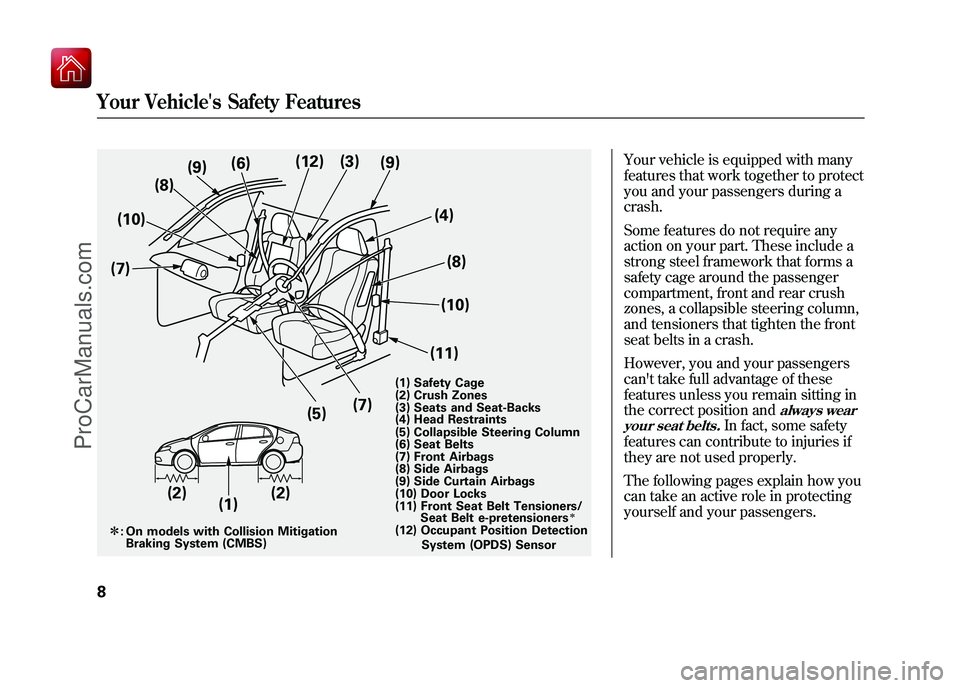
Your vehicle is equipped with many
features that work together to protect
you and your passengers during a
crash.
Some features do not require any
action on your part. These include a
strong steel framework that forms a
safety cage around the passenger
compartment, front and rear crush
zones, a collapsible steering column,
and tensioners that tighten the front
seat belts in a crash.
However, you and your passengers
can't take full advantage of these
features unless you remain sitting in
the correct position and
always wear
your seat belts.
In fact, some safety
features can contribute to injuries if
they are not used properly.
The following pages explain how you
can take an active role in protecting
yourself and your passengers.
On models with Collision Mitigation
Braking System (CMBS)
ꭧ
:
(6)
(1) (2) (3)
(4)
(5)
(7)
(8)
(9)
(11)
(12)
(10)
(7)(9)
(10)(8)
(1) Safety Cage
(2)
(2) Crush Zones
(6) Seat Belts (3) Seats and Seat-Backs
(4) Head Restraints
(7) Front Airbags
(11) Front Seat Belt Tensioners/ (8) Side Airbags
(9) Side Curtain Airbags
(10) Door Locks (5) Collapsible Steering Column
(12) Occupant Position Detection
Seat Belt e-pretensioners
ꭧ
System (OPDS) Sensor
Your Vehicle's Safety Features809/10/28 17:15:37 10 ACURA ZDX KA KC New North America Own 50 31SZN600 enu
ProCarManuals.com
Page 14 of 645
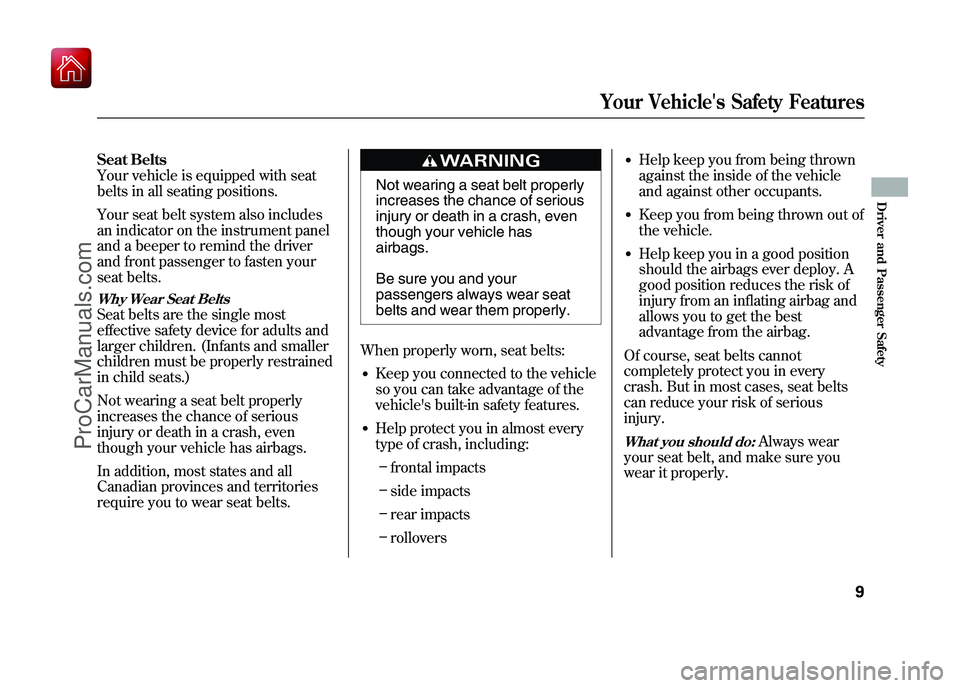
Seat Belts
Your vehicle is equipped with seat
belts in all seating positions.
Your seat belt system also includes
an indicator on the instrument panel
and a beeper to remind the driver
and front passenger to fasten your
seat belts.Why Wear Seat BeltsSeat belts are the single most
effective safety device for adults and
larger children. (Infants and smaller
children must be properly restrained
in child seats.)
Not wearing a seat belt properly
increases the chance of serious
injury or death in a crash, even
though your vehicle has airbags.
In addition, most states and all
Canadian provinces and territories
require you to wear seat belts.
Not wearing a seat belt properly
increases the chance of serious
injury or death in a crash, even
though your vehicle has
airbags.
Be sure you and your
passengers always wear seat
belts and wear them properly.
When properly worn, seat belts:●Keep you connected to the vehicle
so you can take advantage of the
vehicle's built-in safety features.●Help protect you in almost every
type of crash, including: – frontal impacts
– side impacts
– rear impacts
– rollovers
●Help keep you from being thrown
against the inside of the vehicle
and against other occupants.●Keep you from being thrown out of
the vehicle.●Help keep you in a good position
should the airbags ever deploy. A
good position reduces the risk of
injury from an inflating airbag and
allows you to get the best
advantage from the airbag.
Of course, seat belts cannot
completely protect you in every
crash. But in most cases, seat belts
can reduce your risk of serious
injury.What you should do:
Always wear
your seat belt, and make sure you
wear it properly.
Your Vehicle's Safety Features
9
Driver and Passenger Safety
09/10/28 17:15:37 10 ACURA ZDX KA KC New North America Own 50 31SZN600 enu
ProCarManuals.com
Page 19 of 645
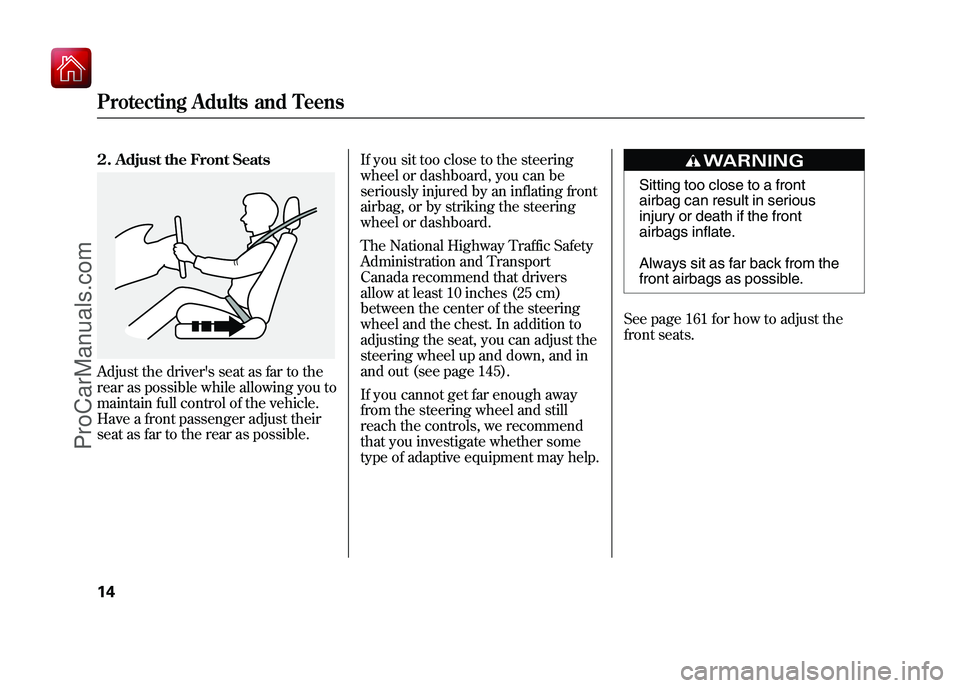
2. Adjust the Front SeatsAdjust the driver's seat as far to the
rear as possible while allowing you to
maintain full control of the vehicle.
Have a front passenger adjust their
seat as far to the rear as possible.If you sit too close to the steering
wheel or dashboard, you can be
seriously injured by an inflating front
airbag, or by striking the steering
wheel or dashboard.
The National Highway Traffic Safety
Administration and Transport
Canada recommend that drivers
allow at least 10 inches (25 cm)
between the center of the steering
wheel and the chest. In addition to
adjusting the seat, you can adjust the
steering wheel up and down, and in
and out (see page 145).
If you cannot get far enough away
from the steering wheel and still
reach the controls, we recommend
that you investigate whether some
type of adaptive equipment may help.
Sitting too close to a front
airbag can result in serious
injury or death if the front
airbags inflate.
Always sit as far back from the
front airbags as possible.
See page 161 for how to adjust the
front seats.
Protecting Adults and Teens1409/10/28 17:15:37 10 ACURA ZDX KA KC New North America Own 50 31SZN600 enu
ProCarManuals.com
Page 22 of 645
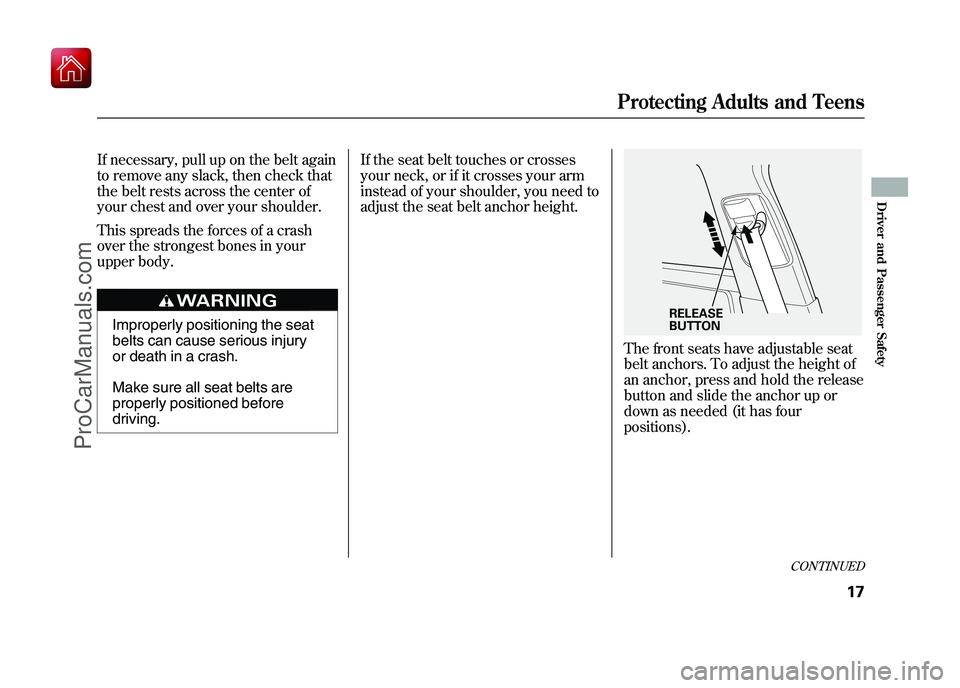
If necessary, pull up on the belt again
to remove any slack, then check that
the belt rests across the center of
your chest and over your shoulder.
This spreads the forces of a crash
over the strongest bones in your
upper body.
Improperly positioning the seat
belts can cause serious injury
or death in a crash.
Make sure all seat belts are
properly positioned before
driving.If the seat belt touches or crosses
your neck, or if it crosses your arm
instead of your shoulder, you need to
adjust the seat belt anchor height.
The front seats have adjustable seat
belt anchors. To adjust the height of
an anchor, press and hold the release
button and slide the anchor up or
down as needed (it has four
positions).
RELEASE
BUTTON
CONTINUED
Protecting Adults and Teens
17
Driver and Passenger Safety
09/10/28 17:15:37 10 ACURA ZDX KA KC New North America Own 50 31SZN600 enu
ProCarManuals.com
Page 23 of 645
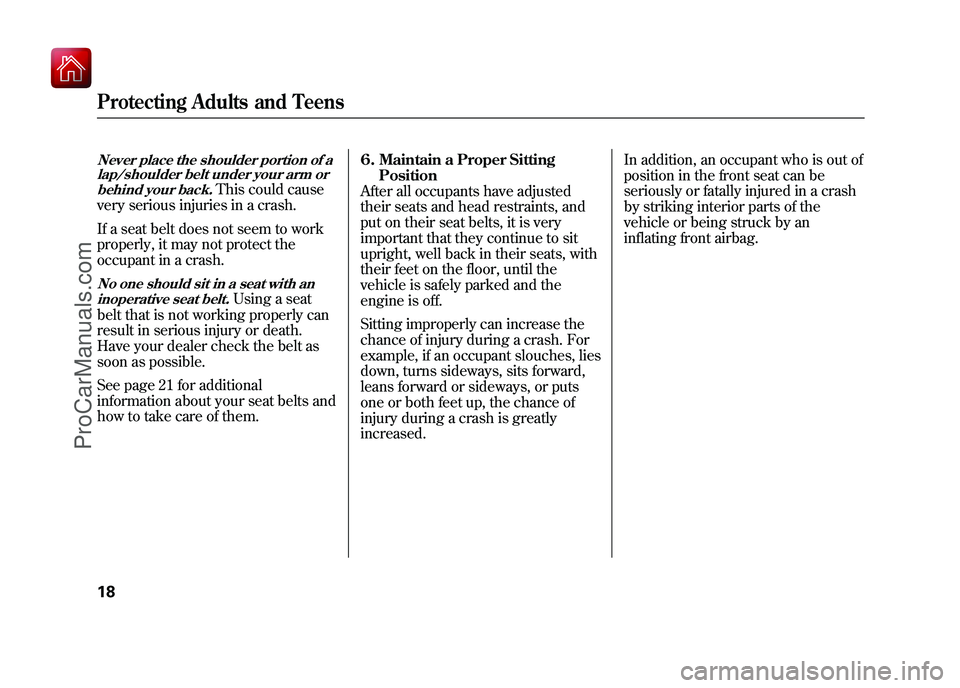
Never place the shoulder portion of alap/shoulder belt under your arm or
behind your back.
This could cause
very serious injuries in a crash.
If a seat belt does not seem to work
properly, it may not protect the
occupant in a crash.
No one should sit in a seat with an
inoperative seat belt.
Using a seat
belt that is not working properly can
result in serious injury or death.
Have your dealer check the belt as
soon as possible.
See page 21 for additional
information about your seat belts and
how to take care of them. 6. Maintain a Proper Sitting
Position
After all occupants have adjusted
their seats and head restraints, and
put on their seat belts, it is very
important that they continue to sit
upright, well back in their seats, with
their feet on the floor, until the
vehicle is safely parked and the
engine is off.
Sitting improperly can increase the
chance of injury during a crash. For
example, if an occupant slouches, lies
down, turns sideways, sits forward,
leans forward or sideways, or puts
one or both feet up, the chance of
injury during a crash is greatly
increased. In addition, an occupant who is out of
position in the front seat can be
seriously or fatally injured in a crash
by striking interior parts of the
vehicle or being struck by an
inflating front airbag.
Protecting Adults and Teens1809/10/28 17:15:37 10 ACURA ZDX KA KC New North America Own 50 31SZN600 enu
ProCarManuals.com
Page 25 of 645
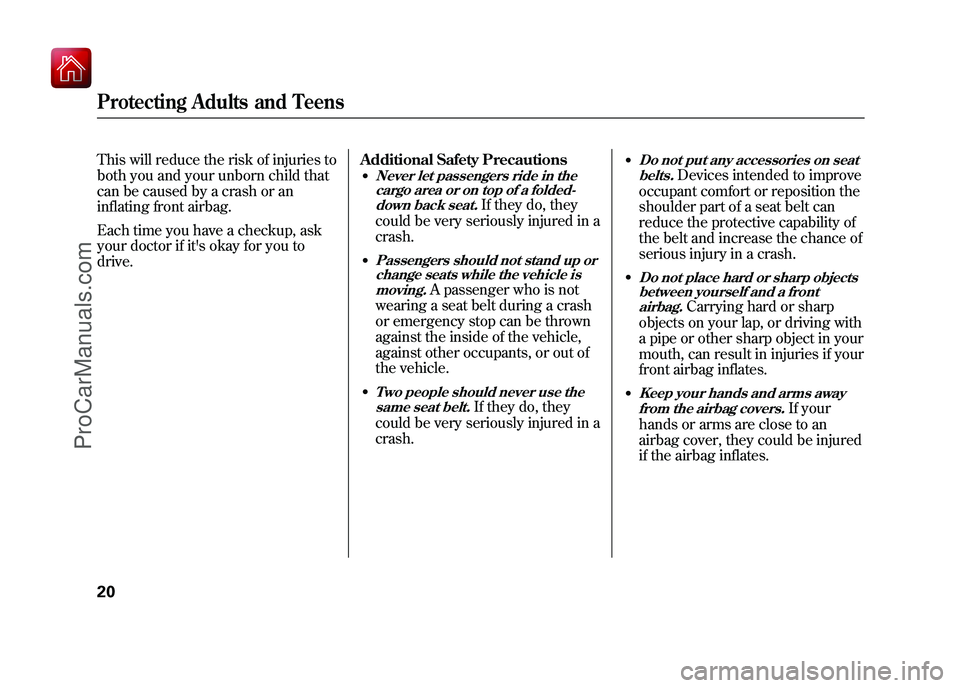
This will reduce the risk of injuries to
both you and your unborn child that
can be caused by a crash or an
inflating front airbag.
Each time you have a checkup, ask
your doctor if it's okay for you to
drive.Additional Safety Precautions
●Never let passengers ride in the
cargo area or on top of a folded-
down back seat.
If they do, they
could be very seriously injured in a
crash.
●Passengers should not stand up or change seats while the vehicle is
moving.
A passenger who is not
wearing a seat belt during a crash
or emergency stop can be thrown
against the inside of the vehicle,
against other occupants, or out of
the vehicle.
●Two people should never use the
same seat belt.
If they do, they
could be very seriously injured in a
crash.
●Do not put any accessories on seat
belts.
Devices intended to improve
occupant comfort or reposition the
shoulder part of a seat belt can
reduce the protective capability of
the belt and increase the chance of
serious injury in a crash.
●Do not place hard or sharp objects between yourself and a front
airbag.
Carrying hard or sharp
objects on your lap, or driving with
a pipe or other sharp object in your
mouth, can result in injuries if your
front airbag inflates.
●Keep your hands and arms away
from the airbag covers.
If your
hands or arms are close to an
airbag cover, they could be injured
if the airbag inflates.
Protecting Adults and Teens2009/10/28 17:15:37 10 ACURA ZDX KA KC New North America Own 50 31SZN600 enu
ProCarManuals.com
Page 29 of 645
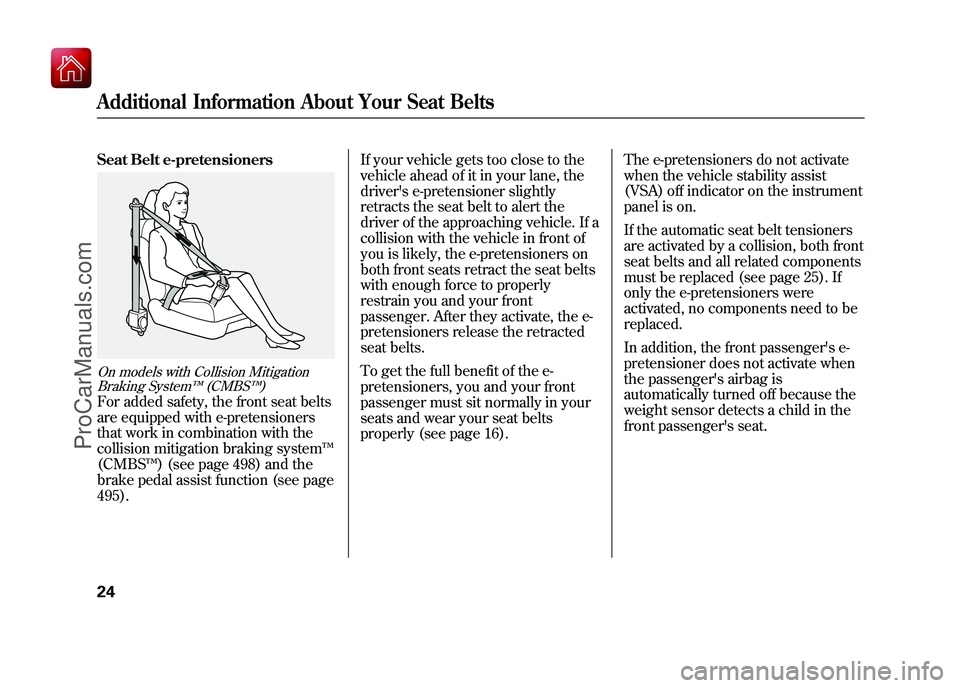
Seat Belt e-pretensionersOn models with Collision MitigationBraking System ™(CMBS ™)For added safety, the front seat belts
are equipped with e-pretensioners
that work in combination with the
collision mitigation braking system ™
(CMBS ™) (see page 498) and the
brake pedal assist function (see page
495). If your vehicle gets too close to the
vehicle ahead of it in your lane, the
driver's e-pretensioner slightly
retracts the seat belt to alert the
driver of the approaching vehicle. If a
collision with the vehicle in front of
you is likely, the e-pretensioners on
both front seats retract the seat belts
with enough force to properly
restrain you and your front
passenger. After they activate, the e-
pretensioners release the retracted
seat belts.
To get the full benefit of the e-
pretensioners, you and your front
passenger must sit normally in your
seats and wear your seat belts
properly (see page 16).
The e-pretensioners do not activate
when the vehicle stability assist
(VSA) off indicator on the instrument
panel is on.
If the automatic seat belt tensioners
are activated by a collision, both front
seat belts and all related components
must be replaced (see page 25). If
only the e-pretensioners were
activated, no components need to be
replaced.
In addition, the front passenger's e-
pretensioner does not activate when
the passenger's airbag is
automatically turned off because the
weight sensor detects a child in the
front passenger's seat.Additional Information About Your Seat Belts2409/10/28 17:15:37 10 ACURA ZDX KA KC New North America Own 50 31SZN600 enu
ProCarManuals.com
Page 35 of 645
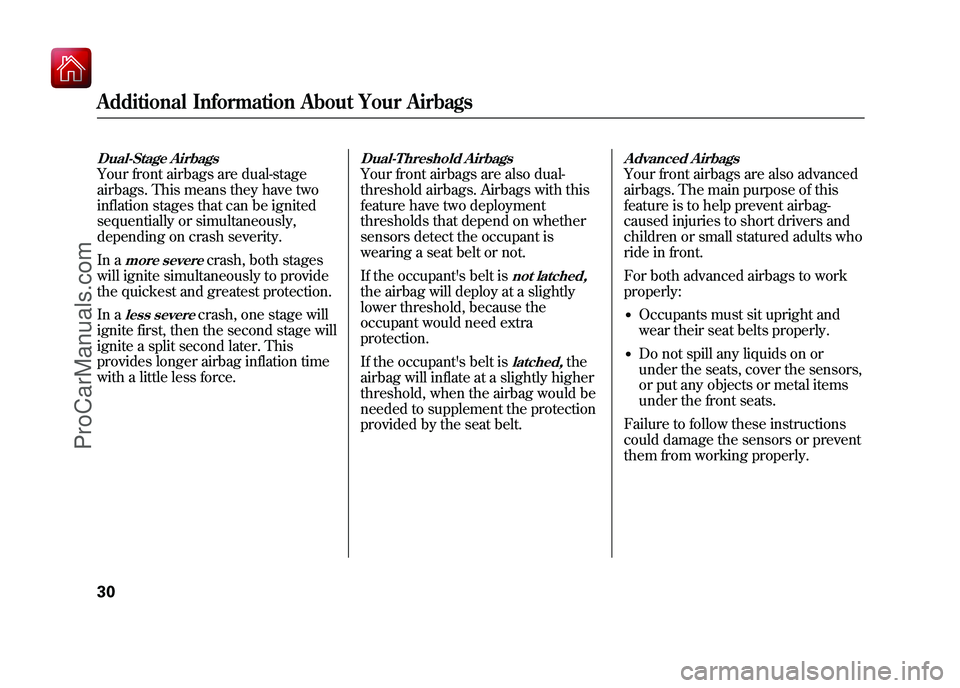
Dual-Stage AirbagsYour front airbags are dual-stage
airbags. This means they have two
inflation stages that can be ignited
sequentially or simultaneously,
depending on crash severity.
In a
more severe
crash, both stages
will ignite simultaneously to provide
the quickest and greatest protection.
In a
less severe
crash, one stage will
ignite first, then the second stage will
ignite a split second later. This
provides longer airbag inflation time
with a little less force.
Dual-Threshold AirbagsYour front airbags are also dual-
threshold airbags. Airbags with this
feature have two deployment
thresholds that depend on whether
sensors detect the occupant is
wearing a seat belt or not.
If the occupant's belt is
not latched,
the airbag will deploy at a slightly
lower threshold, because the
occupant would need extra
protection.
If the occupant's belt is
latched,
the
airbag will inflate at a slightly higher
threshold, when the airbag would be
needed to supplement the protection
provided by the seat belt.
Advanced AirbagsYour front airbags are also advanced
airbags. The main purpose of this
feature is to help prevent airbag-
caused injuries to short drivers and
children or small statured adults who
ride in front.
For both advanced airbags to work
properly:●Occupants must sit upright and
wear their seat belts properly.●Do not spill any liquids on or
under the seats, cover the sensors,
or put any objects or metal items
under the front seats.
Failure to follow these instructions
could damage the sensors or prevent
them from working properly.
Additional Information About Your Airbags3009/10/28 17:15:37 10 ACURA ZDX KA KC New North America Own 50 31SZN600 enu
ProCarManuals.com
Page 37 of 645
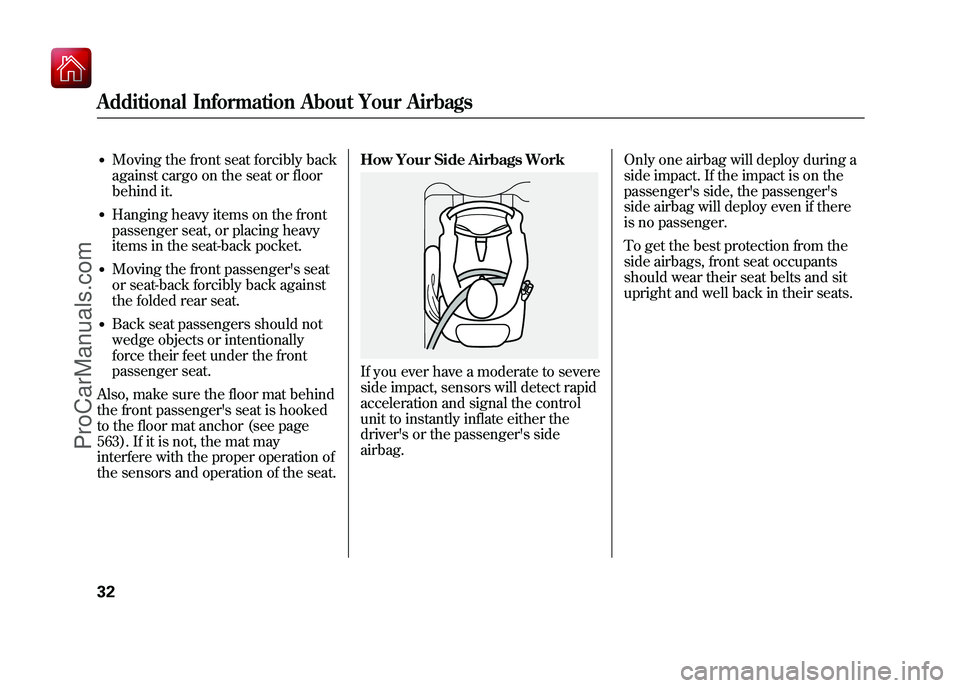
●Moving the front seat forcibly back
against cargo on the seat or floor
behind it.●Hanging heavy items on the front
passenger seat, or placing heavy
items in the seat-back pocket.●Moving the front passenger's seat
or seat-back forcibly back against
the folded rear seat.●Back seat passengers should not
wedge objects or intentionally
force their feet under the front
passenger seat.
Also, make sure the floor mat behind
the front passenger's seat is hooked
to the floor mat anchor (see page
563). If it is not, the mat may
interfere with the proper operation of
the sensors and operation of the seat. How Your Side Airbags Work
If you ever have a moderate to severe
side impact, sensors will detect rapid
acceleration and signal the control
unit to instantly inflate either the
driver's or the passenger's side
airbag.
Only one airbag will deploy during a
side impact. If the impact is on the
passenger's side, the passenger's
side airbag will deploy even if there
is no passenger.
To get the best protection from the
side airbags, front seat occupants
should wear their seat belts and sit
upright and well back in their seats.
Additional Information About Your Airbags3209/10/28 17:15:37 10 ACURA ZDX KA KC New North America Own 50 31SZN600 enu
ProCarManuals.com